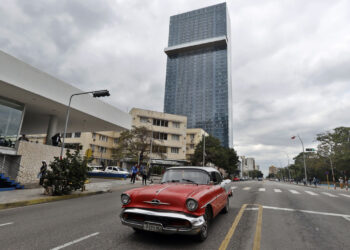Photos: Carolina Vilches
There is no corner of the island more bohemian than El Mejunje in Santa Clara. At El Mejunje, which means “concoction” in English, lovers of all types and creeds converge every day, seeking the ideal place — Silverio’s kingdom. I do not say “kingdom” in a pompous sense; as soon as you walk through the doors, you have the sensation of arriving in a different world.
The host, Silverio, is omnipresent. He is like the guru of the tribe, and his word is law; he does not issue orders but requests, which are fulfilled immediately and gladly. With his quiet step; friendly, well-educated and serene conversation without the slightest bit of petulance; philosophical spirit and great popular wisdom, this man of theater embraces all patrons like old friends. He listens while he talks, like a big brother to all. Nothing escapes him; a bit of unpleasantness might be accompanied by a kind and explicatory comment from him, and you immediately understand. His prestige is his voice; 28 years ago, he asked for the use of some colonial-era ruins in downtown Santa Clara, two blocks from Vidal Park. He assembled a handful of dreamers, and the courtyard gradually became an extremely popular cultural center. Its early participants left their ideas written on the walls, and those scribblings turned into an anthology of graffiti charged with humor and boldness. It was a simple patio and bar with an old record-player, a rustic chair or two and wooden benches. Visual artists added their touches to its decor. It has never had a regular opening or closing time; if somebody shows up with a guitar, you can have a group that ends up singing or dancing any kind of music until dawn, from traditional trova to reggae. Not a day goes by that El Menjuje doesn’t get better. Now, in addition to the central patio for presentations and its legendary bar, the center also features a cozy theater, a gallery and a café/entrance hall, where people chat and sing among the posters that were created for the different events that have been held here.
At El Mejunje, the seven days of the week are not Sunday, Monday and Tuesday…. They are rock, son, transvestites, bolero, trova, theater, children’s activities…. There is space for everyone — young people, seniors and children. A few days ago, I was there, and I sat down for a few minutes to chat with Silverio. This is an opportunity for anyone who visits this place, because he devotes at least a “Welcome!” to everyone who comes. This special host told me that one must always be paying attention, close attention: who are the new people, what interests bring them there, what is happening in the streets, what is missing in people, what are the spiritual needs that need to be met, what is emerging, looking for a place to settle.
We are indebted to Silverio’s kingdom for many things, including having in Santa Clara the most important Cuban singer-songwriter movement at this time: La Trovuntivitis. That is the name of a jam session for trova musicians who have gathered here every Thursday since September 1997.
In his book “La vena del centro: trova santaclareña” (The center vein: Santa Clara’s trova), Alexis Castañeda says that Silverio’s searching gaze found a trova movement that was emerging among university students, and, with his very good nose for these things, he invited its participants to hold a weekly peña, or jam session, at El Mejunje. The trio El trío Enserie, Alain Garrido and Dieguito Gutiérrez began it all on a Thursday 15 years ago, and today, it is a prestigious event where trova musicians come from all over the country, joined by important Latin American singer-songwriters who come filled with curiosity to sing there.
The event’s name apparently was the result of an idea on the part of one of this movement’s most important trova musicians, Roly Berrío. One Thursday, almost all of the musicians were suffering from conjunctivitis (an eye infection), and they went to sing wearing dark glasses. As part of his improvised lyrics, Berrío invented “Trovuntivitis,” and it stuck.
La Trovuntivitis has been an endless source of trova musicians of the likes of Berrío — quite a happening in the Cuban song movement — who, along with Levis Aleaga and Raúl Cabrera, comprise the trio Enserie. Others from its early days, such as Leo García, Dieguito Gutiérrez, Aain Garrido and Raúl Marchena, have led the way for new batches of artists, such as Yaima Orozco, Michel Portela, Yordan Romero, with some of the newest being Irina González, Miguel Ángel de la Rosa, and Karel “El Friki” Fleites. Now, university students have flocked there from their own jam session, “Caña santa,” among the best.
If you want to imbibe from the most bohemian, uninhibited, and unprejudiced Cuban spirituality, you have to go to El Mejunje. In its natural, fun environment, diverse cultural expressions waft through the crowd, and every night is different. It is a place where you learn to appreciate what is shared by everyone there, even if, initially, they may seem to be very different because of their esthetics, music, sexuality, attire or credos. The nights here — which tend to end at daybreak — take place under the banner of peace and understanding among all human beings.
The legend was coming
and our eyes knew
how much we had to grow
and we entered the doorway, our crosses on,
welcome the legend.
Raúl Marchena
I haven’t drunk that much, but I don’t know, almost nothing is certain,
lights in my heart and a low voice that persists.
Everything is spinning around me.
It must be the speed of time’s passing,
the music slipping in among the cigarettes and murmuring
and this happiness that is so infectious.
The moon leaves a slow trail in its wake,
just like yesterday, sinking behind your conversation.
I open the doors to love and looking at you is not enough,
my hands spring out of control, divine message.
I return to the stars and I am natural
can I do anything less when life sings to us?
Leo García










